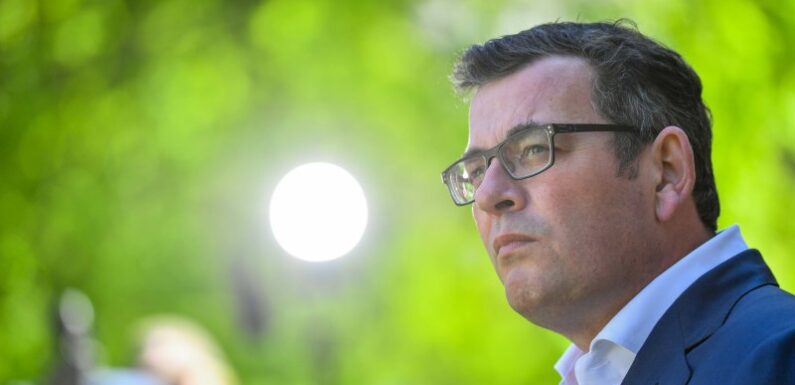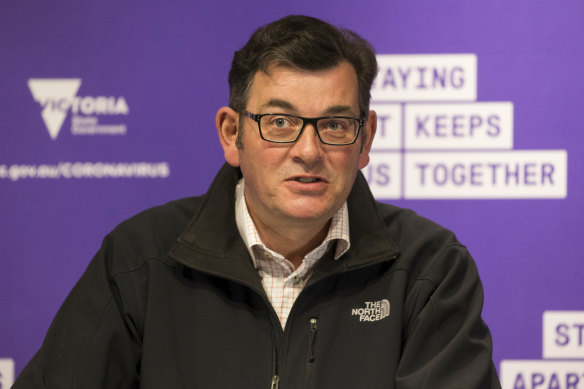
Save articles for later
Add articles to your saved list and come back to them any time.
Wading through the many career epitaphs for Daniel Andrews this past week, I’ve been surprised at the generally negative tone. For me, the defining element of Andrews’ time in office and his overarching legacy will be his vision.
The former Victorian Premier Daniel Andrews in his trademark North Face jacket.Credit: Paul Jeffers
Sure, that North Face jacket – or suit jacket in the event of bad news – at the daily briefings during COVID lockdowns will loom large, as will the phrase “get on the beers”.
But it’s the big picture and future planning that I believe will have long-term impact. This government has overseen the creation of thousands more hospital beds and extended access to home-based care; improved access to hospitals and universities; reduced driving times and congestion and made it safer for pedestrians by removing archaic level crossings; and that’s not to mention massive social reforms.
In news that will surprise no one, that vision and its execution has a cost. As Josh Gordon reported this week, state debt, already the highest in the nation, is expected to rise from about $116.7 billion in net terms to $171.4 billion – equivalent to almost one-quarter of the state economy – in four years. And that’s even after factoring in new levies linked to the government’s COVID Debt Repayment Plan. Those are eye-watering figures, no doubt.
The truth is significant investment in infrastructure was well overdue. Because previous governments had refused to act – to look beyond the next election and commit to making the big decisions required, including investing the funds required – the extent of what needed to be done was enormous.
That’s not because the need wasn’t clear. Calls for a new hospital in Melbourne’s west go back decades, as do pleas for investment in public transport and roads. That we should get rid of level crossings has been clear for a long time, the appetite for doing so, not so much. It takes political courage and boldness to tackle these problems, and an amplified version of both to do so across the board.
The Andrews government also spent big on early learning. It has established dozens of government-owned childcare centres in an effort to make childcare more affordable and more accessible. It made four-year-old kindergarten free from next year, a developmental step shown to have significant impact on a child’s later abilities. The latter was also adopted in NSW and Queensland.
Who is the last premier to make such a massive impact? The name that comes to mind for me is Jeff Kennett, premier from 1992 to 1999, who – apart from Crown casino, Federation Square and the Melbourne Museum – is renowned for tearing things down. His vision and impact was enormous, sadly to the detriment of Victorians. Unless you count slashing public school funding, abolishing the TAFE system, privatising government-owned assets, cutting government services, merging councils, and closing mental health institutions as positives. The adverse repercussions of many of those decisions are still being felt today. Despite their polar opposite politics, some have drawn comparisons between Kennett and Andrews’ autocratic approach to leadership.
Harking back a little further regarding vision in this state, Rupert Hamer’s efforts in the late 1960s and early 1970s to leave the green corridor along the Eastern Freeway vacant showed impressive foresight. He envisaged that one day a train line would be needed to service the burgeoning eastern suburbs. Sadly, subsequent governments on both sides of politics shied away from making it happen, largely because of the significant costs involved. Logistical and planning issues also played a part, as did the prospect of votes lost.
Imagine if just one leader had taken action. The land was ultimately, regrettably, sold off by John Cain’s government in the 1980s. We’ve ended up with a wider freeway and more roads filled by cars, often with single occupants – hardly a positive in a world experiencing the catastrophic impact of climate change.
Without question, there are issues with the way Andrews ran his government and the state. His refusal to engage with the media in the latter part of his premiership, his brushing off of integrity concerns, and the employment of consultants to the tune of many millions all demand further attention.
But my hope is the bigger picture will involve something far more substantial, reflecting that Andrews and his team invested time, strategy and money in much-needed services.
There’s a lot of talk about “hospital passes” being handed to leaders these days. On the infrastructure front, the Andrews government inherited just such a thing, and set about fixing it.
It’s not clear at this point, and won’t be for years, how exactly the Big Build will help Victoria cope with an increasing population, and the inevitable pressure on its infrastructure. Even so, I applaud the commitment to thinking big and acting on it. We desperately need more politicians with vision in this state, country and beyond.
Kerrie O’Brien is a staff writer.
The Opinion newsletter is a weekly wrap of views that will challenge, champion and inform your own. Sign up here.
Most Viewed in Politics
From our partners
Source: Read Full Article
